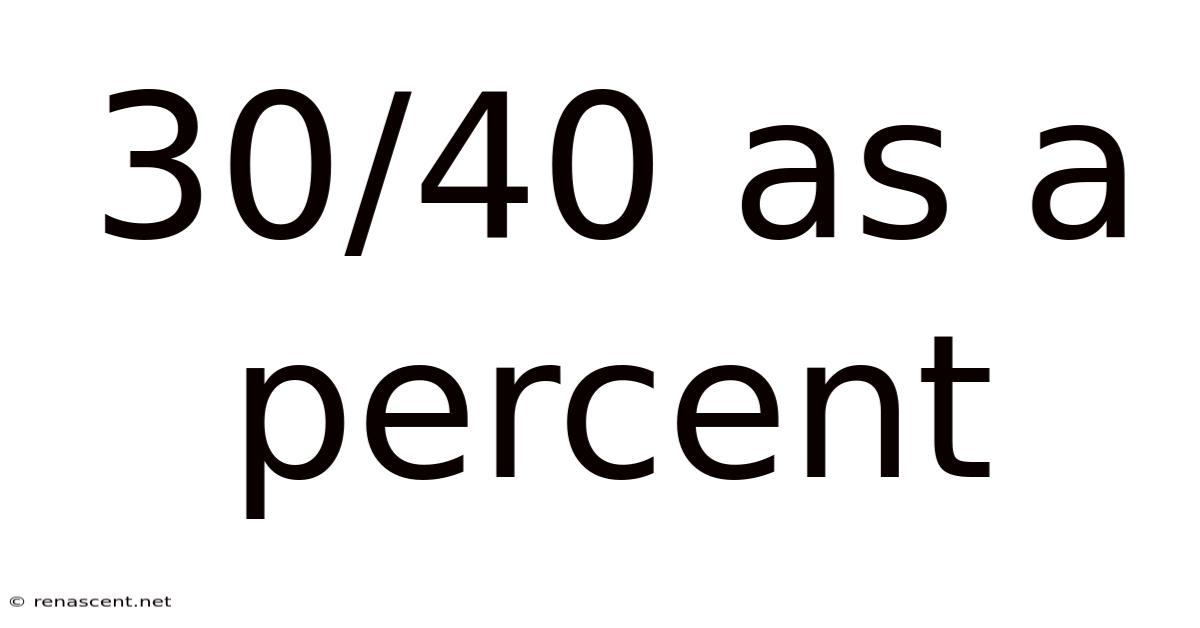30/40 As A Percent
renascent
Sep 23, 2025 · 5 min read

Table of Contents
Decoding 30/40 as a Percentage: A Comprehensive Guide
Understanding fractions and their percentage equivalents is a fundamental skill in mathematics with wide-ranging applications in daily life, from calculating discounts and tips to analyzing data and understanding statistics. This article delves deep into converting the fraction 30/40 into a percentage, exploring the underlying concepts, providing step-by-step instructions, and addressing common related questions. We'll also look at the broader implications of percentage calculations and their relevance in various fields.
Understanding Fractions and Percentages
Before diving into the conversion of 30/40, let's refresh our understanding of fractions and percentages. A fraction represents a part of a whole. It consists of a numerator (the top number) and a denominator (the bottom number). The numerator indicates how many parts we have, while the denominator indicates the total number of parts the whole is divided into.
A percentage, on the other hand, represents a fraction out of 100. The symbol "%" denotes percentage. Essentially, a percentage expresses a proportion as a fraction of 100. For instance, 50% means 50 out of 100, which is equivalent to the fraction 50/100 or ½.
Converting 30/40 to a Percentage: A Step-by-Step Guide
Converting a fraction to a percentage involves two key steps:
Step 1: Simplify the Fraction (if possible)
The first step is to simplify the fraction 30/40 to its lowest terms. This involves finding the greatest common divisor (GCD) of the numerator and denominator and dividing both by it. The GCD of 30 and 40 is 10. Therefore:
30 ÷ 10 = 3 40 ÷ 10 = 4
This simplifies the fraction 30/40 to 3/4. Simplifying makes the subsequent calculations easier and provides a more concise representation of the fraction.
Step 2: Convert the Simplified Fraction to a Percentage
There are two primary methods to convert a simplified fraction to a percentage:
Method 1: Using Division
Divide the numerator by the denominator and then multiply the result by 100%.
3 ÷ 4 = 0.75
0.75 × 100% = 75%
Therefore, 30/40 is equal to 75%.
Method 2: Finding an Equivalent Fraction with a Denominator of 100
We can also convert the simplified fraction 3/4 to an equivalent fraction with a denominator of 100. To do this, we need to find a number that, when multiplied by 4, equals 100. That number is 25 (100 ÷ 4 = 25). We then multiply both the numerator and the denominator by 25:
(3 × 25) / (4 × 25) = 75/100
Since a percentage is a fraction out of 100, 75/100 is directly equivalent to 75%.
The Significance of 75%
Achieving a score of 75% on a test or assignment generally signifies a good understanding of the subject matter. Different institutions and organizations may have varying grading scales, but 75% often falls within the "B" or "Good" range. This indicates a solid grasp of concepts, but there might still be room for improvement.
In business contexts, a 75% market share would indicate a significant dominance in a particular industry. This suggests a strong brand presence and customer loyalty.
In statistical analysis, a 75% confidence interval indicates a high level of certainty in the results obtained.
Practical Applications of Percentage Calculations
Understanding percentage calculations is crucial in numerous everyday situations:
- Financial Calculations: Calculating discounts, sales tax, interest rates, tips, and loan repayments all involve percentages.
- Data Analysis: Percentages are widely used to represent proportions and trends in data sets. This is vital in fields like market research, economics, and scientific research.
- Grading Systems: Educational institutions use percentages to represent student performance and grades.
- Health and Nutrition: Nutrient content in food products is often expressed as percentages of recommended daily intake.
- Probability and Statistics: Percentages are fundamental in calculating probabilities and interpreting statistical data.
Addressing Common Questions
Q: What if the fraction isn't easily simplified?
Even if the fraction isn't easily simplified, you can still use the division method (Method 1) to convert it to a percentage. Simply divide the numerator by the denominator and multiply by 100%. For example, if you have a complex fraction like 123/456, you would calculate 123 ÷ 456 ≈ 0.2697, and then multiply by 100% to get approximately 27%.
Q: How do I convert a percentage back to a fraction?
To convert a percentage back to a fraction, simply divide the percentage by 100 and simplify the resulting fraction. For example, to convert 75% back to a fraction, you would calculate 75 ÷ 100 = ¾.
Q: What are some common percentage equivalents I should know?
It's helpful to memorize some common fraction-percentage equivalents, such as:
- 1/2 = 50%
- 1/4 = 25%
- 3/4 = 75%
- 1/3 ≈ 33.33%
- 2/3 ≈ 66.67%
- 1/5 = 20%
- 1/10 = 10%
Conclusion
Converting 30/40 to a percentage is a straightforward process involving simplification and division or the creation of an equivalent fraction with a denominator of 100. The result, 75%, has significant implications across various fields, highlighting the importance of understanding percentage calculations in daily life and professional settings. Mastering this fundamental concept opens doors to a more profound understanding of numerical relationships and data interpretation. Remember to practice regularly to build confidence and fluency in these essential mathematical skills. Understanding percentages is not just about solving equations; it’s about gaining a clearer picture of the world around us, expressed numerically.
Latest Posts
Latest Posts
-
300 K To C
Sep 23, 2025
-
Integral Of 1 3x
Sep 23, 2025
-
1 4 1 3
Sep 23, 2025
-
300 Grams To Kilograms
Sep 23, 2025
-
140 Fahrenheit In Centigrade
Sep 23, 2025
Related Post
Thank you for visiting our website which covers about 30/40 As A Percent . We hope the information provided has been useful to you. Feel free to contact us if you have any questions or need further assistance. See you next time and don't miss to bookmark.